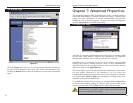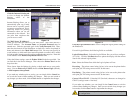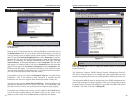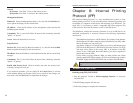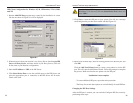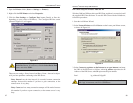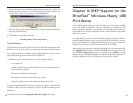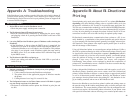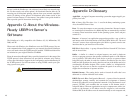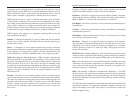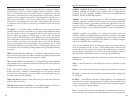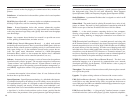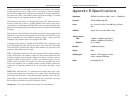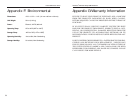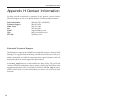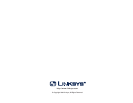
Appendix E:Specifications
Standards: IEEE 802.3 and 802.3u, USB 1.0 and 1.1, PCMCIA 2.0
Protocol: TCP/IP, NetBEUI, AppleTalk
Ports: One 10/100 RJ-45 Port, One USB Port, One Power
Port
PCMCIA: Type II Slot (for use with WPC11 only)
Transfer Speed:
LAN: 10Mbps or 100Mbps (Half Duplex)
20Mbps or 200Mbps (Full Duplex)
Wireless: Up to 11Mbps
Memory: 512KB Flash Memory
Button: Reset
Cabling Type: Network: UTP Category 5 or better
Printer: Standard USB Cable
LEDs: LAN, WLAN, ACT, Err
52
EtherFast
®
Wireless-Ready USB PrintServer
51
scanners, and printers). With USB, a new device can be added to your comput-
er without having to add an adapter card or even having to turn the computer
off. The USB peripheral bus standard was developed by Compaq, IBM, DEC,
Intel, Microsoft, NEC, and Northern Telecom and the technology is available
without charge for all computer and device vendors.
USB supports a data speed of 12 megabit per second. This speed will accom-
modate a wide range of devices, including MPEG video devices, data gloves,
and digitizers. It is anticipated that USB will easily accommodate plug-in tele-
phones that use Integrated Services Digital Network and digital private branch
exchange.
Since October, 1996, the Windows operating systems have been equipped with
USB driver or special software designed to work with specific I/O device types.
USB is integrated into most Windows operating systems. Today, most new
computers and peripheral devices are equipped with USB.
A different “plug-and-play” standard, FireWire/IEEE 1394, is designed to sup-
port much higher data rates and devices such as video camcorders and digital
video disk (digital versatile disk) players. Both standards are expected to exist
together, serving different device types.
UTP - Unshielded twisted pair is the most common kind of copper telephone
wiring. Twisted pair is the ordinary copper wire that connects home and many
business computers to the telephone company. To reduce crosstalk or electro-
magnetic induction between pairs of wires, two insulated copper wires are
twisted around each other. Each signal on twisted pair requires both wires.
Since some telephone sets or desktop locations require multiple connections,
twisted pair is sometimes installed in two or more pairs, all within a single
cable.
WAN (Wide Area Network)- A communications network that covers a rela-
tively large geographic area, consisting of two or more LANs. Broadband com-
munication over the WAN is often through public networks such as the tele-
phone (DSL) or cable systems, or through leased lines or satellites. In its most
basic definition, the Internet could be considered a WAN.
Workgroup - Two or more individuals that share files and databases.
Instant EtherFast
®
Series



